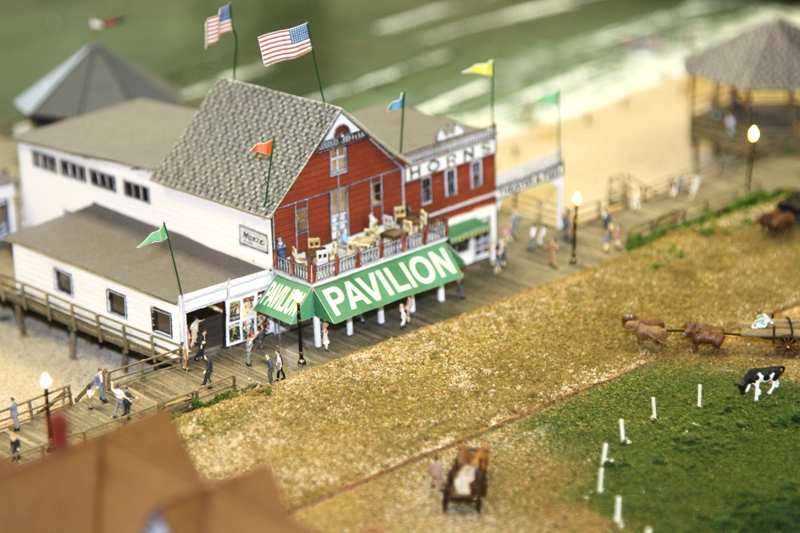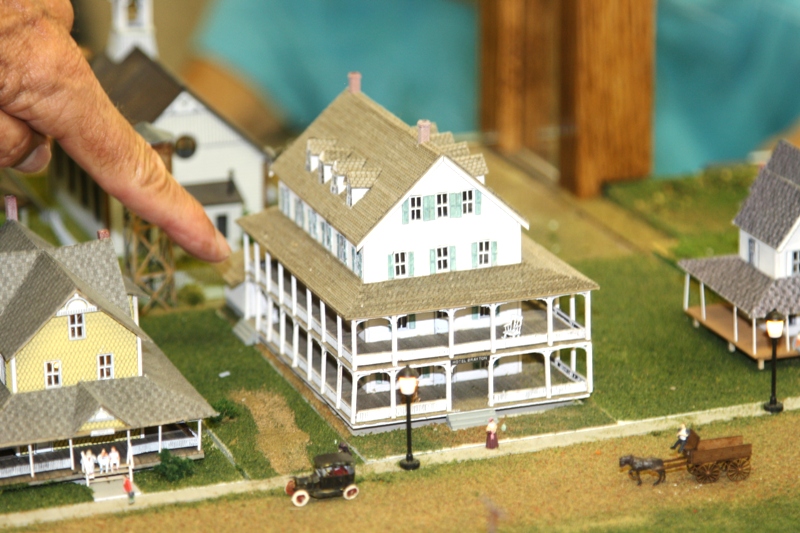Rebuilding Rehoboth History Building by Building
He collects tidbits of Rehoboth Beach history like an entomologist collects insects. Photographs, postcards, newspapers.com articles, insurance company and land records and surveys all help him recreate a nearly perfect replica of 1910 Rehoboth Beach.
Meet Paul Lovett, a local historian who spends several hours each day examining and reconstructing the town’s history. Part of his story is about the history, he says, and the other part is to characterize that history in the 1910 railroad time frame.

Lovett continues to build this detailed N-scale (1:160) replica of Rehoboth Avenue during that railroad era. When he is finished, it will run from the ocean fishing pier known as Horns Pavilion to the west side of the U.S. Government Canal, where the train’s steam engine turned around.
Lovett acts like a general contractor. He creates the specifications for each building, seeks sponsors and hires professional model builders to make the miniatures. About 30 sponsors have participated at $300 to $500 per structure. The models are made from real wood and 3D-printed components. The boardwalk is made board by board. The real boardwalk, he notes, has been completely replaced at least 10 times.

Rehoboth Beach was a railroad town. Train tracks came down the center of Rehoboth Avenue providing passenger service for 50 years from 1878 to 1928. Freight service continued for another 35 years. Rehoboth Avenue was not originally intended for purposes of the railroad, but rather to provide wide vistas to enhance breezes and views. The old downtown area, designed in 1873, was bounded by Christian Street, Lake Avenue and the ocean. That triangular parcel was actually a seaside cranberry farm belonging to Lorenzo Dow Martin. He sold the farm in 1873 to the Methodist-Episcopal Camp Meeting Association. The design of Rehoboth’s streets followed the contours of that farm.

Rehoboth was at its peak in 1910, Lovett points out. The town had gas lamps lit by a lamplighter and a new, noisy electric power and ice-making plant (where First Street Station is today) that spewed coal ash over the town. Livestock was free-roaming including horses, cows, chickens, goats and pigs.
Two new model complexes coming in a few weeks to the diorama are under construction by Lovett’s Miami-based model builder: Thoroughgood Lumber and Cottage that were on the south side of Rehoboth Avenue, across from today’s post office; and Dick’s Grocery Store and adjacent gas station that was on the northwest corner of 1st Street and Rehoboth Avenue. The Newark, Delaware model builder is working on the tables that will be the base for the second and third blocks of Rehoboth Avenue. That will include an operating train. Already on the diorama, the ocean block is finished with about 30 buildings.

“I have studied Rehoboth history for two to three hours a day for about five years,” Lovett says. “I know the history and am recreating it. My primary purpose is to share it with folks like yourselves,” he says.
The diorama will be about 38 feet when it is finally completed. “It needs to find a home in Rehoboth where it will live for generations to come,” Lovett says. It will need to find a new home in the not-too-distant future. In a few more months it will be too large for its current location,” he said. “In the meantime,” he added, “I am so indebted to Main Street for allowing it to be displayed at its offices.”
Lovett has presented the diorama to visitors — which comes with a Rehoboth history lesson — more than 70 times! “I love to share the stories,” he adds. Lovett has written essays about Commodore William H. Shock, a Civil War veteran with a cottage on the boardwalk during the 1890s; Lorenzo Dow Martin, the cranberry farmer who sold his farm that became the core of Rehoboth’s business district; and will soon be writing about the “boardwalk titans.”
To arrange an appointment to see the diorama, please email Lovett, call him at (302) 893-9391 or visit his hobby’s website.


